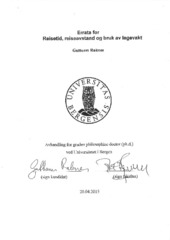| dc.contributor.author | Raknes, Guttorm | en_US |
| dc.date.accessioned | 2015-09-02T06:51:49Z | |
| dc.date.available | 2015-09-02T06:51:49Z | |
| dc.date.issued | 2015-09-02 | |
| dc.identifier.isbn | 978-82-308-2583-9 | en_US |
| dc.identifier.uri | https://hdl.handle.net/1956/10373 | |
| dc.description.abstract | Background and objectives: In the discussion concerning centralisation of out-of-hours (OOH) primary health care services in Norway, travel time and distance have received considerable attention. It has been shown that long distance is associated with lower use of different types of health services. For OOH services, this is insufficiently investigated. The main objectives of this thesis were to characterise travel time and distance to Norwegian casualty clinics, and to examine any association between distance and utilisation of OOH services. Materials and methods: We developed and validated a method to calculate average travel time and distance based on population and post code coordinates of a municipality. Distance to casualty clinic for 417 municipalities were calculated. Activity data were taken from seven representative OOH services, and from OOH reimbursement claims in 2011. The association between distance and OOH utilisation was analysed by exponential regression. The influence from certain organisational, demographic and socioeconomic factors were also examined. Results: Increasing distance to casualty clinic was associated with reduced OOH utilisation, except telephone consultations with a doctor. The demographic and socioeconomic factors had minimal effect on OOH utilisation, but when adjusted for distance, collocation with hospital and participation in inter-municipal services were associated with lower use. The population of the 23 % of municipalities that had more than 40 minutes travel time constituted only five percent of the population. Therefore, recommendations for secondary on-call duty based on long distances apply to only a very small proportion of the population. Conclusion and consequences: Increasing travel time and distance are strongly associated with reduced OOH utilisation. It is crucial to take travel time and distance into consideration when planning the OOH services of the future. Measures to counteract inequalities in OOH utilisation due to long distance should be considered. | en_US |
| dc.description.abstract | Bakgrunn og føremål: I diskusjonen kring sentralisering av legevakttenestene i Noreg har reisetid og reiseavstand fått stor merksemd. Det er vist at lang avstand er assosiert med låg bruk av ulike typar helsetenester, men for legevakt er dette lite undersøkt. Hovudføremålet med avhandlinga var å kartleggje reisetid og reiseavstand til norske legevakter og å undersøkje kva for samanheng dette har med bruken av legevakttenestene. Materiale og metodar: Vi utvikla og validerte ein metode for å rekne ut gjennomsnittleg reisetid og reiseavstand til legevakt basert på folketal og postnummerkoordinatar i kommunen. Avstand til legevakt for 417 av kommunane vart rekna ut med metoden. Aktivitetsdata frå legevakt vart henta frå sju representative legevakter og frå statistikk basert på rekningskort frå legevakt i 2011. Samanhengen mellom avstand og legevaktsbruk vart analysert ved eksponentiell regresjon. Innverknaden frå enkelte organisatoriske, demografiske og sosioøkonomiske faktorar vart også undersøkt. Resultat: Aukande avstand til legevakt var assosiert med redusert bruk av legevakta, bortsett frå telefonkonsultasjonar med lege. Undersøkte demografiske og sosioøkonomiske tilhøve hadde minimal effekt på legevaktbruken, men justert for avstand var samlokalisering med sjukehus og det å høyre til fleirkommunelegevakt assosiert med låg bruk. Folketalet i dei 23 % av kommunane som hadde meir enn 40 minutt maksimal gjennomsnittleg reiseveg, utgjorde berre fem prosent av folketalet. Tilrådingar om bakvakt i legevakt på grunn av avstand og folketal gjeld difor ein svært liten del av befolkninga. Konklusjon og konsekvensar: Aukande reisetid og -avstand er sterkt assosiert med reduksjon i bruken av legevakt. Det er avgjerande å ta omsyn til reisetid og reiseavstand i planlegginga av legevakttenestene i framtida. Tiltak for å motverke ulikskapar i bruk av legevakt på grunn av avstand bør vurderast. | en_US |
| dc.language.iso | nno | eng |
| dc.publisher | The University of Bergen | eng |
| dc.relation.haspart | Paper I: Raknes G, Hansen EH, Hunskaar S. Distance and utilisation of out-of-hours services in a Norwegian urban/rural district: an ecological study. BMC Health Services Research 2013, 13:222. The article is available at: <a href="http://hdl.handle.net/1956/7902" target="blank">http://hdl.handle.net/1956/7902</a> | en_US |
| dc.relation.haspart | Paper II: Raknes G, Hunskaar S. Method paper: Distance and travel time to casualty clinics in Norway based on crowdsourced postcode coordinates. A comparison with other methods. PLoS One 2014, 9: e89287. The article is available at: <a href="http://hdl.handle.net/1956/8825" target="blank">http://hdl.handle.net/1956/8825</a> | en_US |
| dc.relation.haspart | Paper III: Raknes G, Morken T, Hunskår S. Reisetid og avstand til norske legevakter. Tidsskrift for Den norske legeforening 2014; 134(22); 2145-50. The article is not available in BORA due to publisher restrictions. The published version is available at: <a href="http://dx.doi.org/10.4045/tidsskr.14.0437" target="blank">http://dx.doi.org/10.4045/tidsskr.14.0437</a> | en_US |
| dc.relation.haspart | Paper IV: Raknes G, Morken T, Hunskår S. Reiseavstand og bruk av legevakt. Tidsskrift for Den norske legeforening 2014; 134(22); 2151-5. The article is not available in BORA due to publisher restrictions. The published version is available at: <a href="http://dx.doi.org/10.4045/tidsskr.14.0443" target="blank">http://dx.doi.org/10.4045/tidsskr.14.0443</a> | en_US |
| dc.title | Reisetid, reiseavstand og bruk av legevakt | en_US |
| dc.type | Doctoral thesis | |
| dc.rights.holder | Copyright the author. All rights reserved | |
| dc.identifier.cristin | 1260607 | |

